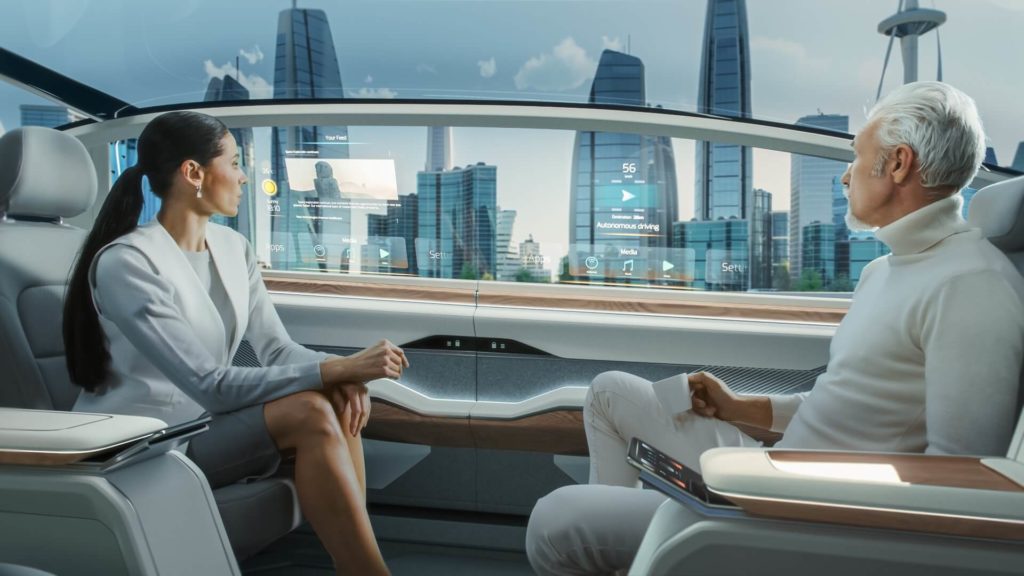The Future of Automotive
The mobility landscape is changing rapidly, and Imagination is already underpinning much of it. Here, we examine how the world of travel is changing.
As we move deeper into the 21st century, transport and mobility are undergoing two changes that are having a significant impact on the entire world: vehicle electrification and vehicle autonomy. Not only are these affecting automotive companies and their supply chains, but they are fundamentally altering how nations as a whole think about mobility.

This first change is the advent of electric vehicles (EVs). Since the car’s invention in the 19th century, motor vehicles have defined personal mobility. Ironically, the earliest cars were powered by batteries, but by the early 20th century the manufacturing of mass-market vehicles propelled by petroleum, primarily by Ford, saw off the electric car. However, after a century of dominance, the sun is setting on the internal combustion engine and electricity is once again set to become the powertrain of choice for personal transport.
This is fundamentally shifting the balance of power in the automotive world, with many bold and brash start-ups challenging car companies with 100-year track records, forcing these industrial giants to respond. The result is an automotive landscape brimming with competition and innovation, bringing benefits to all automobile users.
In the next few years, EVs will grow in popularity.
The three main consumer concerns holding back the rise of EV are charge time, range anxiety and vehicle cost, but with significant innovations in the pipeline, battery technology is set to improve, and costs are lowering. In the next few years, EVs will grow in popularity. The issue of public charging infrastructure will also improve as governments incentivise companies to roll out EV charging points while, in addition, energy suppliers are starting to offer EV friendly home tariffs to match.
While hybrid drivetrains are popular, the focus for car manufacturers is now fully electric vehicles. This means that the old hierarchy, based on their ongoing development of the internal combustion engine, is no longer automatically dominating the market. This is allowing new entrants, defined by different values, to enter the market.
Along with electric, we are seeing the emergence of increasingly sophisticated driver assistance technology, with the goal being autonomous vehicles that are capable of full autonomy.
We are not yet there, but rapid progress is being made due to the advances in semiconductor technology design, GPU advancements and connectivity solutions brought about by companies such as Imagination. Autonomous vehicles (AV) go hand-in-hand with the electric vehicle revolution, because, in this new electric world, rather than just the traditional mechanical engineers, it is now also the software engineers and developers who have a say.
Of course, it’s not just cars that are changing. Thanks to electric power, advances in processing capabilities and new manufacturing techniques, modes of transport that once seemed like science-fiction are stepping closer to reality. The time when autonomous vehicles will be readily available is fast approaching.
The first vehicle we imagine when we think of futuristic vehicles is, of course, the flying car. Many movies, such as the iconic Blade Runner, believed that by 2019 we’d be in flying vehicles, but, as that year recedes into the distance, we still aren’t there yet.
That said, the flying car does exist. Sort of.
Many movies, such as the iconic Blade Runner, believed that by 2019 we’d be in flying vehicles.
Many small, independent companies are competing to develop flying vehicles, from personal jetpacks to flying motorbikes and larger air taxis. Finance is pouring into this area from venture capitalists, always looking for the “next big thing”, and at shows such as CES, companies like Uber are showing off their visions of new forms of mobility. At the same time, regulatory forces are at work to create policies and safety standards that can cope with 3D dimensional travel.
Vertical take-off and landing (VTOL) vehicles, capable of carrying people, will help alleviate traffic and reduce emissions, and once established, will alter the shape of our cities as verticality becomes part of the architectural thinking. Autonomous air taxis, or even personal jetpacks, will become possible, offering improvements in travel options and for search and rescue operations.
These changes will be enabled by the improvements in battery energy density and materials science, and, of course, the development of fast, energy-efficient visual and AI-based processing capabilities. This technology, such as those being developed at Imagination, help to enhance navigation interfaces and enable the creation of autonomous systems we can truly rely on.
While the majority of focus is on creating ground-based vehicles that drive themselves, when it comes to the future of the automotive industry, it’s looking increasingly possible that where we’re going, we won’t need roads…
Related Articles
Artificial Intelligence In Autonomous Vehicles
What Software Is Needed For Autonomous Vehicles
Related Posts
The long and winding road to autonomous cars
How Imagination is steering the automotive industry to a safer future
Unveiling XS: the ultimate GPU family for automotive
Why electric cars matter for the IP electronics industry
Related News
Imagination announces XS, the automotive industry’s most advanced GPU IP
Imagination launches IMG Labs to create breakthrough technologies
Imagination launches IMG B-Series: Doing more with multi-core
